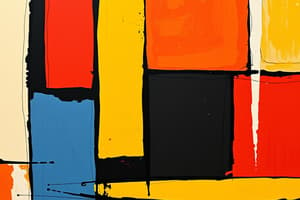Podcast
Questions and Answers
What is the primary purpose of a salutation in a business letter?
What is the primary purpose of a salutation in a business letter?
- To greet and express courtesy to the recipient (correct)
- To state the purpose of the letter
- To introduce the writer's business affiliation
- To express gratitude to the recipient
What is the term for the written version of a drama meant to be performed?
What is the term for the written version of a drama meant to be performed?
- Play
- Script (correct)
- Drama
- Performance
What is the primary function of a complimentary closing in a business letter?
What is the primary function of a complimentary closing in a business letter?
- To express courtesy and respect to the recipient (correct)
- To request action from the recipient
- To express the writer's opinion
- To provide additional information
What is the term for the part of a business letter that provides the gist of the letter?
What is the term for the part of a business letter that provides the gist of the letter?
What is the term for the elements that make up a narrative, such as plot, theme, and setting?
What is the term for the elements that make up a narrative, such as plot, theme, and setting?
What is the primary function of an attention line in a business letter?
What is the primary function of an attention line in a business letter?
What is the term for the part of a business letter that contains the message of the letter?
What is the term for the part of a business letter that contains the message of the letter?
What is the term for the study of the structure and elements of a drama?
What is the term for the study of the structure and elements of a drama?
What is the primary function of a heading in a business letter?
What is the primary function of a heading in a business letter?
What is the term for a type of writing that is not in the form of prose?
What is the term for a type of writing that is not in the form of prose?
Flashcards
Universality (Literature)
Universality (Literature)
Literature's ability to appeal to diverse audiences across cultures, races, and time.
Artistry (Literature)
Artistry (Literature)
Literature's aesthetic quality showcasing artistic expression and beauty.
Intellectual Value (Literature)
Intellectual Value (Literature)
Literature's capacity to stimulate critical thinking and provide insights into life's truths.
Suggestiveness (Literature)
Suggestiveness (Literature)
Signup and view all the flashcards
Spiritual Value (Literature)
Spiritual Value (Literature)
Signup and view all the flashcards
Permanence (Literature)
Permanence (Literature)
Signup and view all the flashcards
Style (Literature)
Style (Literature)
Signup and view all the flashcards
Literary Genre
Literary Genre
Signup and view all the flashcards
Prose
Prose
Signup and view all the flashcards
Business Letter
Business Letter
Signup and view all the flashcards
Study Notes
Literary Standards
- Universality: Literature transcends cultural, racial, and temporal boundaries, appealing to diverse audiences.
- Artistry: Literature is characterized by its aesthetic beauty, offering a sense of artistic expression.
- Intellectual Value: Engages critical thinking and abstract reasoning, prompting insights into fundamental truths of life.
- Suggestiveness: Evokes emotional responses and interpretations through symbolism, nuances, and implied meanings.
- Spiritual Value: Literature inspires and uplifts the spirit, often imparting moral lessons from various genres.
- Permanence: Literature endures through time, maintaining relevance via its timeless themes and messages.
- Style: Reflects unique perspectives on life, showcased through distinctive ideas, structures, and expressions.
Literary Genres
- Defined by dialogue and stage directions, designed for performance.
- Types: Open form (free verse) and closed form (structured).
- Characteristics: Relies on imagery, figurative language, and sound devices.
- Examples:
- Myths and fables
- Novels and short stories
- News articles, essays, and biographies
Poetry
- Definition: A form of language marked by rhythm, figurative language, imagery, sound devices, and emotional expression.
- Types of Poetry:
- Concrete Poem: Visual elements integrated with text.
- Narrative Poem: Tells a story in verse with characters, conflict, and plot.
- Lyric Poem: Expresses personal feelings of a single speaker.
- Other Forms: Epic, ballad, ode, sonnet, elegy, song, dramatic poetry.
Prose
- Definition: The ordinary, straightforward form of written language that mimics spoken language.
- Types:
- Fiction: Includes short stories, novels, legends, and fairy tales.
- Non-Fiction: Encompasses biographies, essays, reaction/reflection papers, diaries, and business letters.
Dramatic Literature
- Definition: A narrative crafted to be performed by actors; scripts can also be read to visualize actions.
- Literary Elements: Includes plot, theme, setting, characters, and conflict.
Business Letters
- Definition: Formal communications for professional contexts.
- Parts of a Business Letter:
- Heading: Contains the date and writer's address.
- Inside Address: Recipient's address including name and title.
- Salutation: Greeting the recipient courteously, followed by a colon.
- Body / Text: The main message of the letter.
- Complimentary Closing: Expression of courtesy before the signature.
- Signature: Writer's name signed; may include optional elements like attention and subject lines to denote focus.
Poetry Structure
- Line Types:
- Couplet: Two lines.
- Quatrain: Four lines.
- Tercet: Three lines.
- Cinquain: Five lines.
Studying That Suits You
Use AI to generate personalized quizzes and flashcards to suit your learning preferences.




